 |
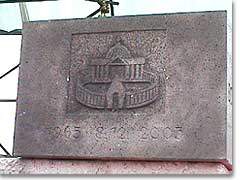 |
| |
La piedra fundamental del Santuario Matri Ecclesiae,
Roma
The corner stone of the Matri Ecclesiae Shrine,
Rome
Der Grundstein des Matri Ecclesiae-Heiligtums,Rom
|
| |
 |
| |
Oración de la Presidencia General, 8 de diciembre,
2003
Prayer of the General Presidium, December 8,
2003
Gebet des Generalpräsidiums, 8. Dezember 2003
|
| |
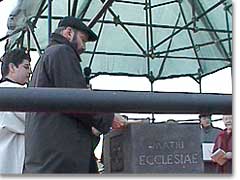 |
| |
Golpe de martillo, P. Heinrich Walter: el martillo
fue usado por el Padre Fundador en la colocación de la piedra
angular de la Iglesia de la Adoración
Hammer blow, Fr. Heinrich Walter: the hammer
was used by Fr. Kentenich at the corner stone laying of the
Adoration Church
Hammerschlag, P. Heinrich Walter: der Hammer
wurde von Pater Kentenich bei der Grundsteinlegung der Anbetungskirche
benutzt.
|
| |
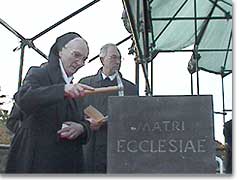 |
| |
Golpe de martillo: Hna. M. Jacoba Kesselheim
Hammer blow: Sr. M. Jacoba Kesselheim
Hammerschlag: Sr. M. Jacoba Kesselheim
|
 |
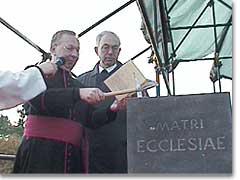 |
| |
Golpe de martillo: Mons. Peter Wolf
Hammer blow: Mons. Peter Wolf
Hammerschlag: Mons. Dr. Peter Wolf
|
| |
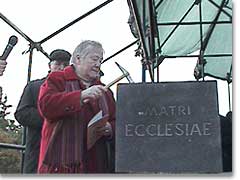 |
| |
Golpe de martillo: Dr. Inge Birk
Hammer blow: Dr. Inge Birk
Hammerschlag: Dr. Inge Birk
|
| |
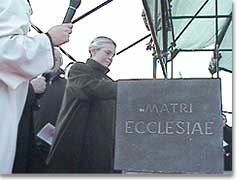 |
| |
Golpe de martillo: Renate Martin
Hammer blow: Renate Martin
Hammerschlag: Renate Martin
|
| |
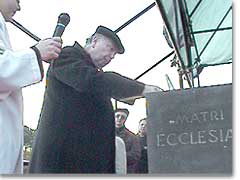 |
| |
Golpe de martillo: P. Dr. Lothar Penners
Hammer blow: P. Dr. Lothar Penners
Hammerschlag: P. Dr. Lothar Penners
Fotos: P. Marcelo Avarena © 2003
|
| |
|
General Presidium
of the International
Schoenstatt Work
Rome, December 9, 2003
Dear Schoenstatt Family
The act of laying the cornerstone for the international shrine in
Rome has brought us together here in the Holy City. What happened here
at this place on the closing day of the Second Vatican Council thirty-eight
years ago, has been accomplished. The General Presidium and other representatives
of the Schoenstatt Family were gathered around the founder, Father
Joseph Kentenich, and by erecting a wayside shrine on the grounds at
the Via di Boccea, symbolically laid the cornerstone. With great joy
our father accepted the gift which the General Presidium presented
to him on his 80th birthday in the name of the whole International
Schoenstatt Work. At that time, they promised to build a shrine in
Rome as well as an international center. Today too, we stand by
this gift and keep the promise made in those crucial and decisive days
in the life of our founder.
Through a telegram he was unexpectedly called back, and, after fourteen
long years of exile and the painful separation from his spiritual family,
he traveled to Rome. Once in Rome, the tension only seemed to increase
until, in a session of the Holy Office, the cardinals repealed all
former resolutions against his person, and the Holy Father Pope Paul
VI confirmed this decision on October 22, 1965. With that, our father
and founder was finally free and, at the same time, had arrived in
the heart of the Church.
Weeks of great joy followed. He gathered the governments of his communities
around himself in Rome, and they were privileged to experience him
in the center of his family. Never before and never afterward was our
founder together with the General Presidium of our movement for so
long a period. Filled with gratitude we look back to the weeks of the "Rome
Talks," the celebration of his 80th birthday, and the conclusion
of the Council on December 8, 1965, with the symbolic act of laying
the cornerstone.
Our father saw this day as a sign which promised a new interaction
between Schoenstatt and the Church in the future. This was to express
what had long been alive in him as a faith-inspired conviction; namely,
that Schoenstatt has a great mission for the Church of the future.
This hope had been alive in his family since 1929; it had found expression
in his words about the "shadow of the shrine," where the "destiny of
the world and Church will be essentially influenced." All that grew
in Schoenstatt through his initiative as the founder was and is intended
to be a contribution for the Church. Due to this conviction, our father
had long been filled with the desire to build a shrine in Rome. As
early as the late forties, he searched for a place for a shrine. The
sisters shared in his desire early on and already before the Council
purchased a piece of land for a shrine on the Via di Boccea in Rome.
The founder was acquainted with this piece of land and visited it three
times. It was on this land that the symbolic laying of the cornerstone
took place on December 8, 1965, and where we celebrated with great
joy the final laying of the cornerstone yesterday.
The name of the future Shrine
Our father and founder personally decided on the name for the future
shrine in Rome: Matri Ecclesiae. With that he chose the inscription
used on the cornerstone for a large church; the cornerstone that had
been blessed by the Holy Father at the solemn closing act of the Council.
The Matri Ecclesiae Shrine will always illustrate that the shrine
and the whole Schoenstatt Movement are a gift to "Mother Church" and
to Mary as Mother of the Church. The Cor Ecclesiae Shrine stands
for the mission and the ideal of Schoenstatt and the Sisters’ family
to be "heart of the Church" with Mary. In the time of acute danger,
the Sisters’ family promised the Blessed Mother to build a shrine for
her in Rome in thanksgiving for granting the request that she restore
our father’s God-given position within the work and the family. Twenty-five
years later, in 1990, the shrine was blessed.
Identification and the alignment of Schoenstatt with the Council.
In his talk on December 8, 1965, which he considered the "Founding
Document" for the shrine in Rome, our founder associated the shrine
in Rome with the question of the new image of the Church after the
Council. He was deeply moved by the idea of the identification and
the alignment of Schoenstatt with the Council. He based it on the
experience and the certainty that what the Council wrestled with regarding
the image of the Church has long been alive in Schoenstatt. Through
the images of the "pilgrim rock" and the "ship," with obvious joy he
captured the new insights and at the same time the dynamics and the
flexibility which the Church newly acquired in the Second Vatican Council.
Quite in the spirit of the Council, he focused on a Church that "soulfully
adheres to tradition" and is "detached from rigid forms." Whenever
we as Schoenstatt members pursue this track, we will give the Church
long-lasting assistance in finding her vital center and in avoiding
the pitfalls of unfruitful extremes. With our founder we strive for
a Church that is "united in a brotherly/sisterly way" and "governed
hierarchically." Whenever we work to promote a family-like / sisterly/brotherly
type of interrelationship, fatherly authority and "family-like obedience," we
contribute to the renewal of the Church and her structures. With the
Second Vatical Council our father shared the vision of a Church that
does not withdraw from the world but has the courage to become "the
soul of the culture and world of today and tomorrow." With prophetic
commitment our father did his utmost that the Church, faithful to her
calling, would have a Marian character, a Marian face, and that Mary
would be increasingly recognized and honored as the "Mother of the
Church." At the same time, he envisioned a "poor Church" that would
abandon all pomp and political power. He was longing for a "humble
Church" capable of asking for forgiveness, as we convincingly experienced
it in these last years through our Pope John Paul II.
Building a Schoenstatt Shrine in Rome cannot mean to simply add another
one to the many churches and chapels. When we build a Schoenstatt Shrine
here, it is meant to express that we want Schoenstatt with its source
of grace and with its stream of life to become a part of the vision
and the practical life of a renewed Church. Wherever we are engaged
to cultivate the above mentioned values and goals in our relationships
and groups, in our parishes and communities, we contribute to the renewal
of the Church and the actualization of the Council. It is in the local
churches that we must strive to realize every day what our father considered
Schoenstatt’s mission for the Church. Through our cooperation and our
apostolic commitment in the parishes and wherever Schoenstatt members
live, our founder’s love for the Church should be realized and continued.
In this sense it is true: "All roads lead to Rome."
A task for the family as a whole
As General Presidium we are in accord with the words of our father
and founder. It is our great concern that we stand together as worldwide
Schoenstatt Family and fulfill the promise made to him by building
the international shrine and center in Rome. Even though it is in accord
with the wish and will of our founder and in accordance with the decision
of the General Presidium that the Schoenstatt Institute of Diocesan
Priests hold the legal title in the realization [of this promise],
they do not act alone but as representatives of the family. It has
always been understood that this great project will be a task for
the family as a whole. We find this expressed in the Curatorium in
Rome in which our communities are represented as in the General Presidium.
This committee conducts and attends to all preliminary discussions
of the details of the plans and all major decisions
A project in two phases of construction
After years of negotiations, we finally received the building permit
and we will undertake the project in two phases of construction.
With the laying of the cornerstone we begin – as is very much in the
spirit of our father – with the shrine as the innermost core of the
future international center in Rome. It is located at the upper part
of the grounds and later will, in a sense, be the crown of our center.
With the start of the construction, we will secure the entire grounds
with a sturdy fence and gates and provide access roads to the shrine.
The first phase of the construction includes a sacristy and a larger
house for a guard to provide accommodations for a guard family and
space for day meetings on the grounds near the shrine. The actual conference
center is planned to follow at an interval of two or three years.
Filling the jars
With the construction of the shrine we are all invited – according
to the Founding Document – to move the Blessed Mother through our contributions
to the capital of grace to establish herself here and to distribute
graces and gifts in abundance. Now it is necessary to make the covenant
of love and to fill the jars as in the Gospel. In this way, the secret
of the fruitfulness of the original shrine shall be repeated, something
that meanwhile has become manifest in many other shrines around the
globe. May this stream of life converge and be consolidated in the
shrine in Rome for the Church on the new shore. We place everything,
all the prayers and sacrifices we offer, our endeavors in our self-education
and the apostolate, into the jars for the Mother Thrice Admirable and
Queen of Schoenstatt. Many of us feel deeply addressed by the challenge
the Holy Father expressed in his Letter Rosarium Virginis Mariae and
like to recite the Rosary. And so, we would like to invite the worldwide
Schoenstatt Family to meditate on the mysteries of the Rosary in a
holy competition of love and to offer them for the shrine in Rome.
At the blessing of the shrine, we will carry the symbolic expressions
of the Rosaries prayed in many countries in large jars to the shrine
and collect there.
It was our father’s will that our communities should not move the
seat of their generalate to Rome. He wanted us to have our mother houses
and our father houses in Schoenstatt and be at home there. Yet it was
important to him that Schoenstatt should establish its presence
in Rome, in the heart of the Church. He wanted us to have representatives
in Rome in the sense of procurements which make our communities present
in Rome and assure our involvement. It was a concern of his that people
should be able to come to know and experience Schoenstatt at the center
of the Church.
A truely International Center
We will have to make targeted efforts that the future center will
reflect the diversity of our Movement and that representatives
of as many communities as possible will be present there. It is necessary
that in the heart of the Church we will establish contacts with Vatican
authorities, with other ecclesial movements, and with all apostolic
forces in the Church. We want to realize the goal that Schoenstatt
will be perceived in Rome as an international movement and not primarily
as a German foundation. For that reason our center needs an international "occupying
staff," an international presentation and radiating aura.
The Schoenstatt Institute of Diocesan Priests and the Curatorium in
Rome are dreaming that there will be areas and rooms in this center
which express the specific character of individual countries in the
worldwide Schoenstatt Family, donated and organized by them.
The Schoenstatt Institute of Diocesan Priests and the Curatorium in
Rome are envisioning that as many Schoenstatt members as possible in
the whole world will be able to say with joy and pride that, by contributing
a building stone, they have cooperated in this large common project.
As the General Presidium we gladly share in these hopes. The future
international shrine and center in Rome is our common enterprise, a
gift from all of us to our father and with him to the Church.
United in the covenant of love, greetings from Rome
General Presidium
(signatures of all the members of the General Presidium)